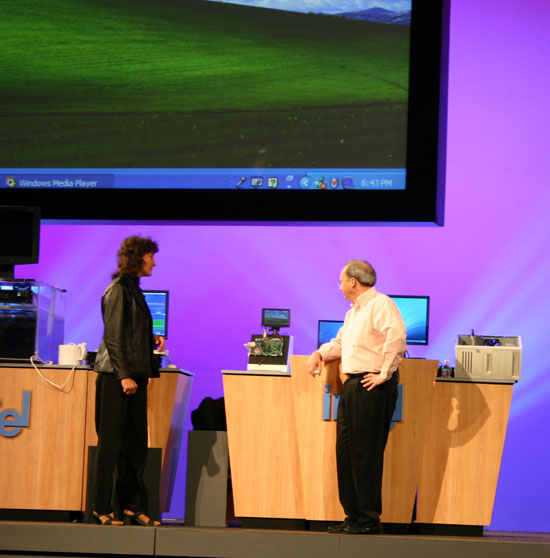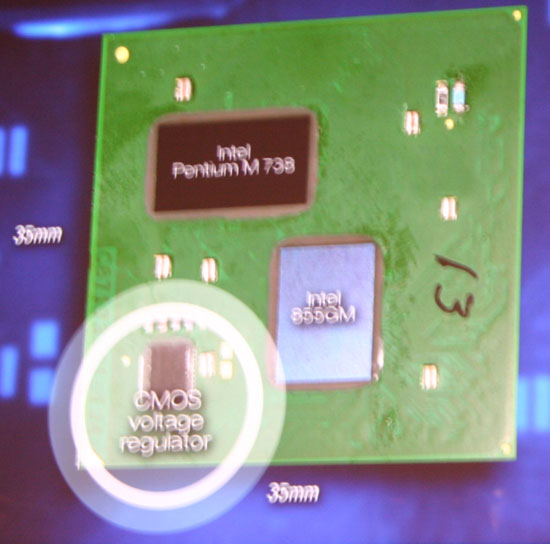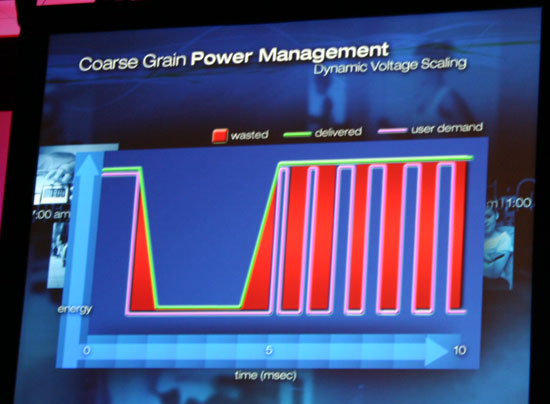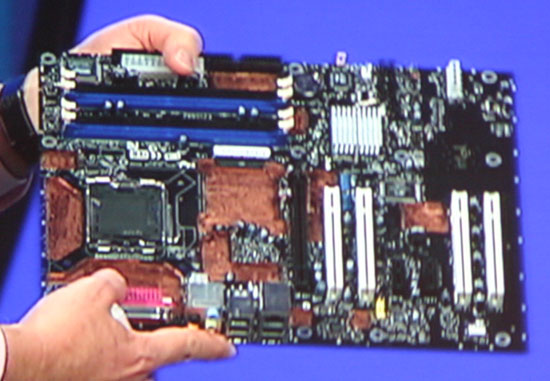Fall IDF 2005 - Day 3: Intel Demos On-Chip North Bridge & Voltage Regulator
by Anand Lal Shimpi on August 25, 2005 12:39 PM EST- Posted in
- Trade Shows
One of the biggest performance and technology advantages AMD has hold over Intel has been their on-die memory controller and North Bridge. Not only does AMD's on-die memory controller increase performance, but it saves overall system power as it can take advantage of the CPU's power management and advancements in microprocessor manufacturing technology.

Intel went in a slightly different direction today and showcased a research project of a Pentium M processor with an on-package GMCH, or North Bridge with integrated graphics.

Obviously this is different from doing an on-die north bridge, but you do get some significant performance benefits from moving the GMCH on chip. Note that the graphics core is also on the package, which is something we've heard AMD may be working on, but we were actually able to see a working demo from Intel today.

The integration went one step further, and included an on-package CMOS voltage regulator. The idea behind this integration step is that conventional voltage regulators on motherboards are relatively slow, they can't switch between voltage levels too quickly. They especially can't switch at the same rate as CPU demand changes:

Current Technology, the green line represents voltage and the blue spikes represent CPU demand
By moving to an on-package CMOS voltage regulator you not only simplify the motherboard, but you also get much faster voltage switching, meaning the voltage regulator can actually switch more frequently with CPU demand - resulting in something like the graph below.

CMOS based voltage regulators will enable much finer grained switching
Intel didn't commit to a timeframe of introducing this technology, but given that they had working silicon, we can expect that this project is something they truly wish to pursue.

A prototype motherboard using the technology. Note the lack of voltage regulators on the motherboard and the missing GMCH (North Bridge) chip.










36 Comments
View All Comments
bradley - Saturday, August 27, 2005 - link
It' about time.ksherman - Friday, August 26, 2005 - link
I do have to say that the idea of the n chip voltage control is VERY exciting, especially for mobile processors... mabye AMD will put it on-die...johnsonx - Friday, August 26, 2005 - link
"but you do get some significant performance benefits from moving the GMCH on chip"Why? If it's just the same Pentium-M communicating over the same FSB to the same GMCH, why does putting it on the same package help performance more than a little bit? I can see maybe tightening some bus timings a little, but nothing significant.
That said, I do certainly agree this idea is a good one for small form-factor devices that still need substantial CPU power.
joex444 - Friday, August 26, 2005 - link
Isn't Intel the company that changes a slight bit of a CPU, calls it a new revision and requires a new chipset, which means new motherboard? Why would they take away from their own MB sales by putting the NB on chip?UltraWide - Friday, August 26, 2005 - link
Does this mean we will no longer need monster heatpipe 5LB heatsinks and 12,000rpm Delta fans???joex444 - Friday, August 26, 2005 - link
I have no idea why you would come to that conclusion. With many of the NB chips needing active cooling and graphics cores putting out some heat (even the Intel ones do that, to a lesser extent than Nvidia or ATIs), and voltage regulators also putting out some heat, I'd think we would need to use the same heatsinks, because Intel's CPUs are supposed to produce less heat, but with all this extra crap on the PCB, it should equal out, give or take. Perhaps if Intel is able to ramp up the speed of their uber next-gen uarch then the heat will be somewhat similar to today's CPUs (but a lot more performance), and the NB, Gfx, VR will make it more heat productive than today, so even bigger HSFs.bupkus - Friday, August 26, 2005 - link
As I look at the graph of both Coarse Grain Power Management and Fine GPM it seems pretty clear this is an exercise in reducing the "red" or saving power. If a cpu is just doing email it can run like a single core whatever. If not it can fire itself up for more power.Larso - Friday, August 26, 2005 - link
The only way I can make any sense out of the graphs, is if it's actually the cpu frequency that's scaling, hence the need for changing the voltage. Some kind of speedstep with faster transisions?On the other hand, if the frequency is constant, the voltage is also constant and power consumption is determined by current draw. This is what a voltage regulator do by the way, it keeps the voltage constant regardless of current draw.
Perhaps the point they are trying to make is that voltage regulation is more effecient now that it is on chip. But in that case the graphs are completely bogus.
sprockkets - Thursday, August 25, 2005 - link
With that much integration you can pretty much forget putting your own processor in the mb; it looks more like it has to be preinstalled.Didn't VIA show something like that to begin with? Their processor and NB on one package for a mini-ITX board?
Rock Hydra - Friday, August 26, 2005 - link
I don't see why you would. AMD doesn't need to have it integrated, so neither does Intel, I would assume. Also I'm thinking this would bring down motherboard prices, but I'm thinking CPU prices are going to be high as a result.